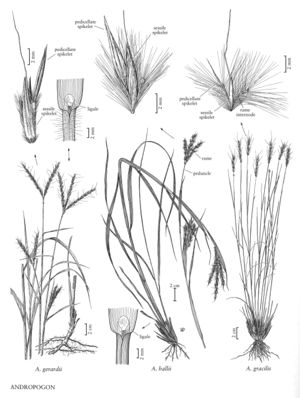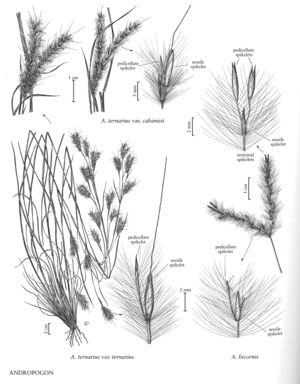Plants perennial; usually cespitose, sometimes rhizomatous. Culms 20-310 cm, erect, much-branched distally. Leaves not aromatic; ligules membranous, sometimes ciliate; blades linear, flat, folded, or convolute. Inflorescences terminal and axillary or a false panicle; inflorescence units 1-600+ per culm; peduncles initially concealed by the subtending leaf-sheaths, sometimes exserted beyond the sheaths at maturity, with (1) 2-5 (13) rames; rames not reflexed at maturity, axes slender, terete to flattened, not longitudinally grooved, usually conspicuously pubescent, with spikelets in heterogamous sessile-pedicellate pairs (the terminal spikelets sometimes in triplets of 1 sessile and 2 pedicellate spikelets), apices of the internodes neither cupulate nor fimbriate; disarticulation in the rames, below the sessile spikelets. Sessile spikelets bisexual, awned, with short, blunt calluses; lower glumes 2-keeled, flat or concave, usually not veined between the keels, sometimes 2-9-veined; anthers 1, 3 (2). Pedicels usually longer than 3 mm, similar to the rame internodes in shape, length, and pubescence color, not fused to the rame axes. Pedicellate spikelets usually vestigial or absent, sometimes well-developed and staminate. x = 10.
Distribution
Minn., Conn., N.J., N.Y., Wis., Del., D.C, Man., Ont., Que., Sask., W.Va., Pacific Islands (Hawaii), Ark., Ariz., Calif., Ga., La., Md., Miss., N.C., N.Mex., Nev., Puerto Rico, S.C., Tex., Va., Virgin Islands, Fla., Wyo., N.H., Ala., Ill., Ind., Kans., Ky., Mass., Mich., Mo., Okla., Pa., R.I., Tenn., Utah, Maine, Vt., Colo., N.Dak., Nebr., S.Dak., Iowa, Ohio, Mont.
Discussion
Andropogon is a cosmopolitan genus of tropical and temperate zones, comprising approximately 120 species. Thirteen species are native to the Flora region. Andropogon bicornis has been found in the region but is not known to be established. All but A. hallii grow in the southeastern United States.
Several taxa are ecologically important in North America. Andropogon gerardii is one of the most important native grasses in North America, being one of the dominant species in the tall-grass prairies that used to cover the center of the continent. Many varieties of A. glomeratus and A. virginicus aggressively colonize abandoned fields, cutover timberlands, and roadsides. Some species are used in restoration and landscaping.
Species of Andropogon with solitary rames are easily confused with Schizachyrium but, in Andropogon, the lower glumes of the sessile spikelets are flat or concave and the rame internodes are not cupulate, whereas Schizachyrium has convex glumes and rame internodes with strongly cupulate apices. Successful identification of species in Andropogon sect. Leptopogon (numbers 3-14) requires mature, complete specimens and careful field study (Campbell 1983, 1986).
Selected References
Key
| 1 | Pedicellate spikelets usually well-developed, (3.5)6-12 mm long, usually staminate; sessile spikelets 5-12 mm long (sect. Andropogon). | > 2 |
| 2 | Sessile spikelets with awns 8-25 mm long; ligules 0.4-2.5 mm long; hairs of the rame internodes 2.2-4.2 mm long, sparse to dense; rhizomes sometimes present, the internodes usually less than 2 cm | Andropogon gerardii |
| 2 | Sessile spikelets unawned or with awns less than 11 mm long; ligules (0.9)2.5-4.5 mm long; hairs of the rame internodes 3.7-6.6 mm long, usually dense; rhizomes always present, the internodes often more than 2 cm long | Andropogon hallii |
| 1 | Pedicellate spikelets usually vestigial or absent, those of the terminal spikelet units occasionally well-developed and staminate; sessile spikelets 2.6-8.4 mm long (sect. Leptopogon). | > 2 |
| 3 | Peduncles with solitary rames; plants of southern Florida | Andropogon gracilis |
| 3 | Peduncles with (1)2-13 rames; plants of varied distribution, including southern Florida. | > 4 |
| 4 | Rames not or scarcely exserted at maturity; peduncles mostly less than 15 mm long at maturity. 5. Culms 30-140 (usually about 80) cm tall; blades 0.8-5 (usually about 2.5) mm wide; inflorescence units 2-31 per culm | Andropogon gyrans |
| 5 | Culms 20-250 (usually more than 90) cm tall; blades 1.7-9.5 (usually more than 3) mm wide; inflorescence units 3-600 per culm. | > 6 |
| 6 | Blades pubescent, most hairs appressed; callus hairs 1.5-5 mm long | Andropogon longiberbis |
| 6 | Blades glabrous or with spreading (rarely appressed) hairs; callus hairs 1-3 mm long. | > 7 |
| 7 | Blades 11-52 cm long; sheaths smooth, rarely somewhat scabrous; ligules 0.2-1 mm long; keels of the lower glumes usually smooth below midlength, scabrous distally | Andropogon virginicus |
| 7 | Blades 13-109 cm long; sheaths usually scabrous; ligules 0.6-2.2 mm long; keels of the lower glumes sometimes scabrous below midlength | Andropogon glomeratus |
| 4 | Rames sometimes exserted above their subtending sheaths at maturity; 1 or more peduncles more than 15 mm long at maturity. | > 5 |
| 8 | Anthers 3. | > 9 |
| 9 | Sessile spikelets 4.5-8.4 mm long; pedicellate spikelets 1.5-3.6 mm long, sterile; plants common and widespread in the southeastern United States | Andropogon ternarius |
| 9 | Sessile spikelets 3-4 mm long; pedicellate spikelets mostly vestigial or absent, those of the terminal spikelet units well-developed and staminate; in the Flora region, known only from southern Florida | Andropogon bicornis |
| 8 | Anthers 1 (rarely 3). | > 9 |
| 10 | Peduncles with 2-13 rames | Andropogon liebmannii |
| 10 | Peduncles usually with 2 (infrequently up to 4) rames or (in A. gyrans var. gyrans and A. virginicus var. virginicus), 2-5 (infrequently up to 7) rames. | > 11 |
| 11 | Culms 30-120(140) (usually less than 100) cm tall; blades 0.8-5 (usually less than 3) mm wide; inflorescence units 2-31 per culm. | > 12 |
| 12 | Peduncles with 2-5 rames; anthers 0.6-1.7 mm long; sessile spikelets (3)4.1-4.4(5.7) mm long | Andropogon gyrans |
| 12 | Peduncleswith 2 rames; anthers 1.2-2 mm long; sessile spikelets (4)4.8-5(5.5) mm long | Andropogon tracyi |
| 11 | Culms (20)90-310 (usually more than 100) cm tall; blades 1.7-9.5 (usually more than 3) mm wide; inflorescence units 5-210 per culm. | > 12 |
| 13 | Upper portion of the plants open, the branches conspicuously arching | Andropogon brachystachyus |
| 13 | Upper portion of the plants dense, the branches usually straight and erect to ascending. | > 14 |
| 14 | Rame internodes usually densely and uniformly pubescent over their entire length; anthers 1.3-3.5 mm long; sessile spikelets (3.8)4-6.1 mm long. | > 15 |
| 15 | Blades 15-35 cm long, often more or less pubescent; sheaths smooth, very rarely somewhat scabrous; anthers 2-3.5 mm long; inflorescence units 5-45 per culm | Andropogon arctatus |
| 15 | Blades 32-61 cm long, usually glabrous; sheaths often scabrous; anthers 1.3-2 mm long; inflorescence units usually at least 50 (9-210) per culm | Andropogon floridanus |
| 14 | Rame internodes sparsely pubescent basally, more densely pubescent distally; anthers 0.5-1.5 mm long; sessile spikelets 2.6-4(5). | > 15 |
| 16 | Blades 11-52 cm long; sheaths smooth, rarely somewhat scabrous; ligules 0.2-1 mm long; keels of the lower glumes usually smooth below midlength, scabrous distally | Andropogon virginicus |
| 16 | Blades 13-109 cm long; sheaths usually scabrous, sometimes smooth; ligules 0.6-2.2 mm long; keels of the lower glumes sometimes scabrous below midlength | Andropogon glomeratus |
"decumbent" is not a number.


